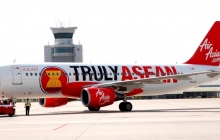AirAsia was launched in 2001 with the dream of making flying possible for everyone. Since then, AirAsia has swiftly risen to become the world’s best...
-

Air Travel
Where to invest?
Air Travel
The move towards an ASEAN Single Aviation Market boosted infrastructure investment and aviation development plans in the region. Growth is also attributed to the proliferation of low-cost carriers. Demand for flights rose with the expansion of the middle income class, driving regional competition and positively impacting the industry of aviation.
Passenger growth
Analysts anticipate that almost half of the world’s air traffic growth will be driven by travel to, from, and within the Asia-Pacific region during the next 20 years. According to Frost & Sullivan, total passenger throughput from ASEAN airports is expected to increase from 211 million passengers in 2011 to 233 million passengers by 2014. Thailand’s airport which makes up for almost 25% of the ASEAN’s total throughput is expected to grow 2.6% from 2011 to 2014. Thailand’s passenger throughput in 2011 was at 52.7 million passengers. The Philippines, with 24 million passengers in 2011 is expected to show the highest growth rate at an average of 4.6% from 2011 to 2014.
Aircraft demand
Boeing forecasts that Southeast Asian airlines combined will acquire 2,750 new airliners in the next 20 years, as reported in an Allurentis publication titled “Investing in ASEAN”. The company projects that Southeast Asia’s current fleet of 1,050 commercial aircrafts will increase to 3,150 by 2030. Predicted market value of the fleet increase is US$ 410 billion.
The development of low-cost carriers is driving demand for new airplanes. In 2011, Malaysian-owned Air Asia inked an US$ 18-billion contract with Airbus for the purchase of 200 A320 NEO jets. Lion Air, the fastest growing budget airline in Indonesia, made waves when it ordered 230 Boeing planes amounting to US$ 21 billion. Less than two years after, Lion Air broke its own record by signing a contract with Airbus worth 18.4 billion Euro for the acquisition of 234 A320 aircrafts.
Non-budget airlines are also into buying spree. Philippine Airlines is under an aggressive re-fleeting program. In August 2012, the airline entered into a US$ 7 billion-contract for the purchase of 54 Airbus planes and, recently, announced plans to buy additional aircrafts from Boeing. Thai Airways is looking into its purchase plan for Boeing’s dreamliner jets.
Demand is also high among airline companies in newer ASEAN member states. Lao Airlines invested US$ 47 million for two ATR 72-600 aircrafts. Orders are coming from Viet Nam upon the operation of new budget airline VietJetAir.
Airport developments
ASEAN has seen high growth of airport development during 2010 to 2012. In two years, it has seen the rise of 21 new airports, bringing the total airports in the region to 1,189 as of 2012. Developments are expected to continue with ASEAN countries set to engage in airport construction and expansion.
Malaysia is developing a US$ 1.27 billion low cost carrier terminal in Kuala Lumpur along with plans to position its international airport as a regional hub. Indonesia’s Soekarno Hatta International Airport is building a new terminal to allow Jakarta to accommodate 62 million passengers per year by 2014. Expansion plans are also underway for Bali Airport.
Meanwhile, Singapore announced its plans for the S$ 600 million-development of Changi Airport’s Terminal 4. With a planned capacity of 16 million passenger movements a year, T4 will enable Changi to increase its total airport capacity from 73 million to 82 million passengers per year. Along with plans to build a fourth terminal is the construction of additional parking stands estimated to cost S$ 680 million.
The Philippines is turning to public-private partnerships to rehabilitate its plane hubs including the Mactan International Airport in Cebu and the domestic airports in Bohol, Laguindingan, and Puerto Princesa.
Viet Nam also unveiled its airport development plans which include the construction of a new airport at Long Thanh worth over US$ 6.75 billion. The airport, to be located northeast of Ho Chi Minh City, is set to start in 2015 and will be built in three phases.
-
Air travel has a valuable role in accelerating the Integration of ASEAN economies. As the region pushes for open skies and move towards a single aviation market, dreams of seamless connectivity among the 10 ASEAN countries and its neighbours is definitely within reach.
SUCCESS STORIES
-
- Site Map
- Terms & Abbreviations

